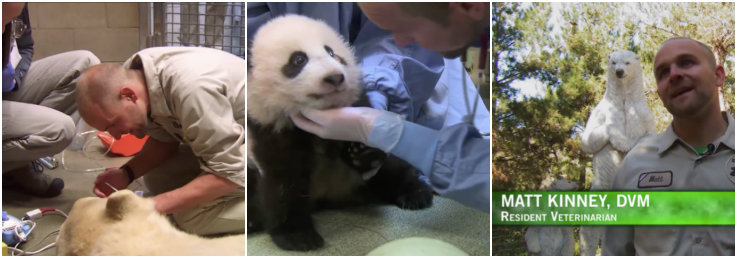Veterinary specialty spotlight: Zoo Veterinarian

In our last blog we followed a day in the life of an aquatic veterinarian. And in continued celebration of National Aquarium and Zoo Month, we will take a deeper look into another veterinarian specialty: zoo and exotic animal medicine.
Similar to aquatic veterinarian, the role of a zoo vet takes a team. Working in a zoo or animal sanctuary a zoo veterinarian works in partnership with keeper staff, managerial staff and veterinarians — all with a love for animals and a common goal to maintain their health and safety.
Typical duties for a zoo vet may include:
- Performing exams
- Administering sedation as well as fluids
- Taking samples and giving vaccinations
- Prescribing medication
- Performing surgery
- Cleaning teeth
- Taking ultrasounds and radiographs
- Treating wounds
- Assisting with captive breeding programs
- Supervising zoo veterinary technicians
As a veterinarian or exotic animal vet, you may also be involved with research studies and participating in educational events for the public.
As like for many veterinarian specialties, work can extend outside the usual office hours, including some nights and weekends, as well as being on call for emergencies.
Caring for exotic animals can also pose some special challenges that other veterinary specialties and those working with small or domestic animals don’t encounter as regularly.
“Exotic animals try to hide their disabilities and symptoms all the time, because they know if they’re shown to be weak in nature, they get eaten,” said Thomas Colville, DVM, attending veterinarian at the Red River Zoo in North Dakota. “Companion animals try to hide their symptoms as well, but not to the same degree.”
This again emphasizes the importance of zoo staff working as a team to monitor animals for any irregularities as they go through their daily routines.
However, with the challenges of this specialty come great rewards.
Now the Program Director of Smithsonian’s Global Health Program, Dr. Susan Murray was once the chief veterinarian at the Smithsonian National Zoo in 2007 and recalls in an interview with Smithsonian Magazine, “there is an exciting moment every single day.”
“Each one is a little bit different, whether it’s coming up with a treatment for coral, diagnosing a problem in a Burmese python, or visiting an elephant we’re hoping is pregnant. There’s really no way to compare. Every day offers a bounty of surprises.”
For more insight into a day in the life of a zoo vet, check out the video below by the San Diego Zoo as one veterinarian walks you through his daily routine.
Biology program students at William Woods University interested in pursuing a future as a veterinarian will want to start preparing now with the skills and knowledge needed to be admitted into competitive graduate programs for veterinary medicine. Through our Pre-Vet concentration and Pre-Vet club, students are able to gain hands-on experience working with large animals as well as learning from and shadowing veterinarians in the surrounding area.

